
The Lattice C Compiler was released in June 1982 by Lifeboat Associates and was the first C compiler for the IBM Personal Computer. The compiler sold for $500 and would run on PC DOS or MS-DOS. The first hardware requirements were given as 96KB of RAM and one floppy drives. It was ported to many other platforms, such as mainframes (MVS), minicomputers (VMS), workstations (UNIX), OS/2, the Commodore Amiga, Atari ST and the Sinclair QL.
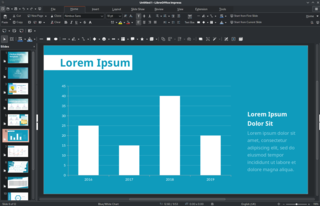
In computing, a presentation program is a software package used to display information in the form of a slide show. It has three major functions:
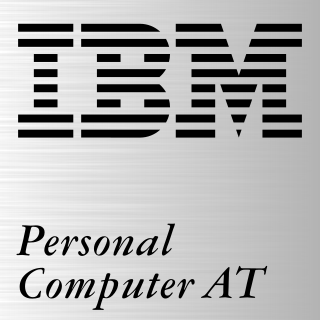
The IBM Personal Computer AT was released in 1984 as the fourth model in the IBM Personal Computer line, following the IBM PC/XT and its IBM Portable PC variant. It was designed around the Intel 80286 microprocessor.
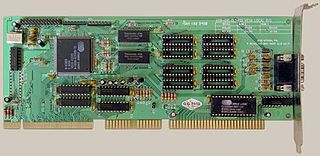
Super VGA (SVGA) is a broad term that covers a wide range of computer display standards that extended IBM's VGA specification.

Columbia Data Products, Inc. (CDP) is a company which produced the first legally reverse-engineered IBM PC clones. It faltered in that market after only a few years, and later reinvented itself as a software development company.

Clip art is a type of graphic art. Pieces are pre-made images used to illustrate any medium. Today, clip art is used extensively and comes in many forms, both electronic and printed. However, most clip art today is created, distributed, and used in a digital form. Since its inception, clip art has evolved to include a wide variety of content, file formats, illustration styles, and licensing restrictions. It is generally composed exclusively of illustrations, and does not include stock photography.

PC Magazine is an American computer magazine published by Ziff Davis. A print edition was published from 1982 to January 2009. Publication of online editions started in late 1994 and continues as of 2023.

Imaging for Windows from Global 360 is document imaging software. Earlier versions of Imaging for Windows were available for Windows 95-98/Me/NT/2000. Global360 Imaging for Windows is the upgrade to this Imaging software, which was discontinued as of Windows XP. Its image viewing, editing and scanning functions are superseded by Windows Picture and Fax Viewer and Microsoft Paint, both of which are based on GDI+ in Windows XP. However, the multi-page picture editing functions are gone with the Imaging software.
Interactive Systems Corporation was a US-based software company and the first vendor of the Unix operating system outside AT&T, operating from Santa Monica, California. It was founded in 1977 by Peter G. Weiner, a RAND Corporation researcher who had previously founded the Yale University computer science department and had been the Ph. D. advisor to Brian Kernighan, one of Unix's developers at AT&T. Weiner was joined by Heinz Lycklama, also a veteran of AT&T and previously the author of a Version 6 Unix port to the LSI-11 computer.

The IBM 3270 PC, released in October 1983, is an IBM PC XT containing additional hardware that, in combination with software, can emulate the behaviour of an IBM 3270 terminal. It can therefore be used both as a standalone computer, and as a terminal to a mainframe.
Photogenics is raster graphic editing software produced by Idruna Software.
Aldus PhotoStyler was a graphics software program developed by the Taiwanese company Ulead. Released in June 1991 as the first 24 bit image editor for Windows, it was bought the same year by the Aldus Prepress group. Its main competition was Adobe Photoshop. Version 2.0 introduced a new user interface and improved color calibration. PhotoStyler SE - lacking some features of the version 2.0 - was bundled with scanners like HP ScanJet. The product disappeared from the Adobe product line after Adobe acquired Aldus in 1994.
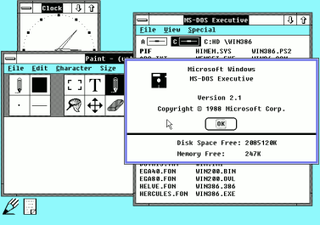
Windows 2.1 is a major release of Microsoft Windows. It was released to manufacturing on May 27, 1988, as a successor to Windows 2.0.
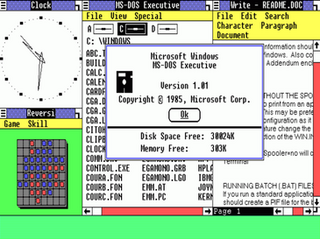
Windows 1.0 is the first major release of Microsoft Windows, a family of graphical operating systems for personal computers developed by Microsoft. It was first released to manufacturing in the United States on November 20, 1985, while the European version was released as Windows 1.02 in May 1986.
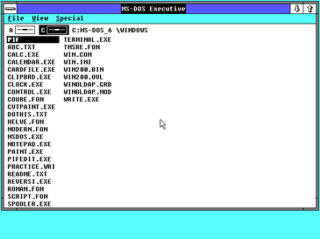
Windows 2.0 is a major release of Microsoft Windows, a family of graphical operating systems for personal computers developed by Microsoft. It was released to manufacturing on December 9, 1987, as a successor to Windows 1.0.
Zeynep Çelik-Butler is a Turkish-American professor of electrical engineering at the Nanotechnology Research and Teaching Facility within the College of Engineering at the University of Texas at Arlington. There are two distinctly different areas of research within the group.

PC Globe is an atlas for MS-DOS, Microsoft Windows, Apple Macintosh and Atari ST, first released in 1987 by Comwell Systems Inc. It offered information on 177 countries and dependencies.
Robert W. Lafore is a computer programmer, systems analyst and entrepreneur. He coined the term "interactive fiction", and was an early software developer in this field.
VREAM, Inc. was a US technology company that functioned between 1991 and 1996. It was one of the first companies to develop PC-based software for authoring and viewing virtual reality (VR) environments.
PerfectDisk is a defragmentation software product for Windows developed by Raxco.













